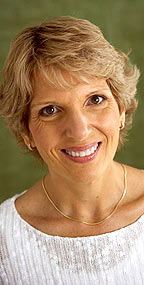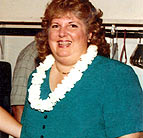In her video on the website she refers to the 3 - P's that kept her going:
Prayer, Program and Perseverance.
 After |
| ||||||||||||||||||||||
Having once tipped the scales at 282 pounds, Jane is convinced that without her faith—and the Weight Watchers plan—she wouldn't be wearing a size 6 today.
In August 2001 my sister got married, and I was her matron of honor. Later, when I saw the pictures from the wedding, I was absolutely horrified. I just cried because I couldn't believe I looked like that. And the video—the video was even worse. It made me feel so depressed. I thought, "I don't want to live like this; I hate the way I look." I was carrying 282 pounds, and I'm 5 feet 4 inches tall.
While I was crying, I got down on my knees and prayed. I said, "God, I can't do this on my own. I need you to help me." I had prayed for help before, but this time I gave it over to God. I acknowledged that I couldn't do it on my own.
My dad, who passed away when I was 17, really instilled the importance of faith in me. My husband and I have been part of a wonderful church for the last 20 years, and, in addition to our two grown kids, our congregation is like our family, so praying was nothing new for me. But this prayer was different. It was a desperate plea for help.
I've battled my weight my whole life. I went on my first diet when I was 9 years old, and I've tried just about everything that's come along since—the grapefruit diet, high-protein diets, liquid diets, even Fen-Phen, the drug combination that was taken off the market in 1997 because it caused heart valve problems in some people. I'd lose 5 or 10 pounds, then gain 20, lose 20, and gain 40. Even though my weight-loss attempts were a losing battle, hardly a day has gone by that I haven't worried about my weight or tried to watch what I eat.
I was never one of those people who overate regularly. Sure, I overate at times and I ate fattening foods— I love ice cream—but I also have a terrible metabolism. It's not an excuse. It's reality. I'd eat the same slice of cake that everyone else ate, but it would make me gain weight. It was enormously frustrating.
In 1999, I was diagnosed with an under-active thyroid, which can cause a slow metabolism, and I went on medication to increase my thyroid function. That helped a little; I didn't seem to gain weight quite as easily after that. But by then I was so heavy, it didn't make much difference.
I tried to convince myself that being fat was OK—some people are just heavier than others—but in my heart I knew I could never be happy as a fat person. I'd cry when I couldn't find things to wear and I hated to go shopping. I never looked at my body in the mirror, because I didn't want to see how big I was. I'm a nurse and I am the vice president of my company's home-care division. I felt as if I was in control of my life and successful in every aspect except for my weight. It was awful.
After seeing the pictures from the wedding and asking for God's help, I joined Weight Watchers on September 8, 2001. My goal was to get down to 155 pounds. A part of me didn't believe I would ever get there because I'd failed so many times before. But I developed a routine that I still do to this day: I started to get up at 4:30 a.m. for quiet time—Bible reading and prayer. I'd say verse 13 of Philippians, chapter 4: "I can do all things through Him who strengthens me." Then I'd go for a fast two-mile walk. I always hated exercise—hated thinking about it, hated doing it. But I made up my mind that I was going to do everything I could to make this effort work.
I wish I could say the weight loss was easy, but it wasn't. There were plenty of upsetting setbacks. I remember going to a meeting after what I thought was a really good week, and the scale told me I was up 4 pounds. I was so upset; I couldn't stay through the meeting. At that point, I still had more than 100 pounds to lose, and I thought, "I'll never get there at this rate. I'll be 100 years old by the time I reach goal."
When I got home, I went into my bedroom and got on my knees. I said, "Okay, God. I'm really feeling discouraged. I need help." And then it came to me that God was trying to teach me a lesson. I needed to learn to accept setbacks and to keep believing in myself through them. I had many, many bad days after that, but because I saw them as lessons, they fueled my determination. When I'd gain a pound or two, I'd tell myself, "I'm not going to let this defeat me."
One day, I went out for my daily morning walk, and as I was striding along I had an unbelievable epiphany: I was enjoying it. Not only did I like walking, but I felt really good. I was eating healthy food and I liked it. The compulsion to eat foods that made me fat was just gone. It may sound hokey, but I think God took it away because every time I felt as if I was losing control, I would say that verse from Philippians, and a sense of peace would come over me. In any case, during that walk I realized that I was cured, healed. Somehow, I just knew that this time—for the first time ever—the weight loss was going to stick. And I knew it was because God was helping me.
I reached my initial goal in February 2006, and then lost another 22 pounds by July.* I've weighed 133 pounds ever since. Recently at work I heard someone describe me as "the tiny little woman over there." I thought, "What? They can't possibly be talking about me." But they were. When I think about the last six years, I realize it hasn't been so much a weight-loss journey as a journey of faith. I'm proud of myself and proud of my effort. But without God's help, I wouldn't be wearing a size 6 today.
